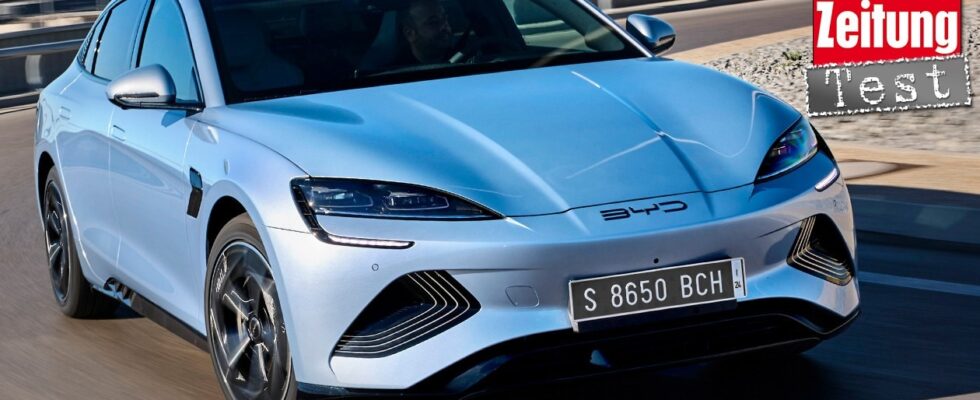BYD is a fixture in the automotive business – as an (electric) car manufacturer, but primarily in its home country of China. The worldwide distribution takes place mainly with the in-house batteries, which can be found in the Models 3 and Y from Tesla, for example. Now “Build Your Dreams” attacks the important customer with a beautiful limousine.
The BYD Seal, together with the compact Stromer Dolphin, belongs to the “Ocean Aesthetics” line, which in terms of design is based on everything to do with the sea. Hence the names. At 4.80 meters long, 1.88 m wide and 1.46 m high, it is slightly larger than Tesla’s Model 3 in all dimensions, and that’s no coincidence. The “seal” wants to trump the US competitor. This does not work in every area (especially not with the charging capacity), but the optics were well received by the invited journalists at the first presentation. The front in particular stands out clearly from the somewhat contourless face of the Model 3. And behind it there is also a so-called frunk (front trunk) in the Seal, in which 53 liters of luggage fit. However, the main trunk leaves a lot to be desired with 402 liters. The interior is completely different. It is rather opulent here, in the front and in the back even tall people feel comfortable. What is due to the 2.92 meter wheelbase, but also to the great seats and the high-quality appearance: beautiful materials, haptically and visually appealing, and a very harmonious design. They could have saved themselves the plastic only on the tapering center console. There is a gear selector lever that is reminiscent of BMW in its crystal design, surrounded by a few buttons and two small rollers for driving mode and volume. Behind it (or in front of it, depending on your perspective), two smartphones can lie peacefully next to each other and be charged inductively. Apple CarPlay and Android Auto should hopefully also work wirelessly by the time they are launched in Europe in autumn. The steering wheel feels good in the hand, you can also use real buttons instead of touch elements. Thank you, BYD! “Signature Tool” in the Seal: the touchscreen that can be rotated at the push of a button, ideally 15 inches in size and razor-sharp. The operating system is clear, the graphics fast. Detailed investigations were not possible because the test vehicles were cars for the Chinese market – with the corresponding system language. Phosphate battery that does not require cobalt or nickel and, in the event of an accident, does not catch fire as easily as a lithium-ion battery. On the other hand, the whole thing is processed using cell-to-body technology, ie the battery is fully integrated into the vehicle structure. This brings advantages in terms of space, efficiency and rigidity. The durability of the blade battery is also particularly good. BYD also wants to support this with gentle charging and therefore dares to give a ten-year guarantee with no mileage limit for 80 percent of the capacity. The Seal’s battery has a capacity of 82 kW, the maximum charging capacity is 150 kW. The manufacturer specifies 26 minutes as the charging time from 30 to 80 percent. Other manufacturers can do this faster, although the BYD Seal can increase its voltage from 400 to up to 750 volts when charging. The Seal charges three-phase with alternating current with 11 kW. Powerful drive BYD offers two drives for the Seal: In each case, a rear motor with 230 kW/313 hp drives the rear axle. In this case, the sedan sprints from 0 to 100 km/h in 5.9 seconds. The WLTP range is specified as 570 kilometers. The all-wheel drive vehicle has an additional 160 kW motor on the front axle, which means it has a total of 530 hp. Standard sprint: 3.8 seconds, whereas our test drives showed 3.9 seconds on the display. The WLTP range here is 520 kilometers. The top speed of both versions is limited to 180 km/h. The standard heat pump is good for the real range. Adaptive chassis as standard During the first test drives with the China version, the Seal impressed with an almost luxurious driving experience. No engine noise, no wind noise and a smooth, comfortable chassis (adaptive as standard). In a slalom test, the car could be steered nimbly through the pylons. For the European market, the steering should be a little more direct and the chassis should be a little firmer. Market launch in late autumn Prices have not yet been officially announced. But when the BYD Seal comes onto the market in late autumn, it should probably be in the list with between 45,000 and 57,000 euros. But that’s not set in stone – until then there is still a lot to do on the market (see the constant price capers at Tesla). The bottom line is that the BYD Seal is a promising competitor if the final vote is a little more “European”.
source site-13
